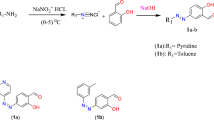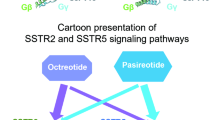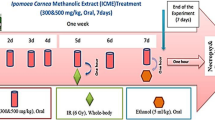Abstract
Among the somatostatin analogues, octreotide (OCT) is the most commonly used in clinic via intravenous or subcutaneous injection to treat various diseases caused by increased secretion of growth hormone, gastrin or insulin. In order to assesse the feasibility of developing oral formulations of OCT, we conducted systematical pharmacokinetic and pharmacodynamic analyses of OCT in several animal models. The pharmacokinetic studies in rats showed that intragastric administration of OCT had extremely low bioavailability (<0.5%), but it could specifically distribute to the gastric mucosa due to the high expression of somatostatin receptor 2 (SSTR2) in the rat stomach. The pharmacodynamic studies revealed that intragastric administration of OCT dose-dependently protected against gastric mucosal injury (GMI) in mice with WIRS-induced mouse gastric ulcers, which were comparable to those achieved by intravenous injection of OCT, and this effect was markedly attenuated by co-administration of CYN-154806, an antagonist of SSTR2. In pyloric ligation-induced ulcer mice, we further demonstrated that OCT significantly reduced the secretion of gastric acid via down-regulating the level of gastrin, which was responsible for the protective effect of OCT against GMI. Overall, we have provided pharmacokinetic and pharmacodynamic evidence for the feasibility of developing an oral formulation of OCT. Most importantly, the influence of SSTR2 on the pharmacokinetics and pharmacodynamics of OCT suggested that an oral formulation of OCT might be applicable for other clinical indications, including neuroendocrine neoplasms and pituitary adenoma due to the overexpression of SSTR2 on these tumor cells.
Similar content being viewed by others
Log in or create a free account to read this content
Gain free access to this article, as well as selected content from this journal and more on nature.com
or
References
Lamberts SW, Krenning EP, Reubi JC. The role of somatostatin and its analogs in the diagnosis and treatment of tumors. Endocr Rev 1991; 12: 450.
Sun L, Coy DH. Somatostatin and its Analogs. Curr Drug Targets 2016; 17: 529–37.
Liu HL, Huo L, Wang L. Octreotide inhibits proliferation and induces apoptosis of hepatocellular carcinoma cells. Acta Pharmacol Sin 2004; 25: 1380–6.
Oberg KE, Lamberts SW. Somatostatin analogues in acromegaly and neuroendocrine tumours: past, present and future. Endocr Relat Cancer 2016; 23: R551–66.
Wang L, Huang X, Chai Y, Zou L, Chedrawe M, Ding Y. Octreotide inhibits the proliferation of gastric cancer cells through P300-HAT activity and the interaction of ZAC and P300. Oncol Rep 2017; 37: 2041–8.
Sener G, Paskaloglu K, Kapucu C, Cetinel S, Contuk G, Ayanoğlu-Dülger G. Octreotide ameliorates alendronate-induced gastric injury. Peptides 2004; 25: 115–21.
Sun H, Zou S, Candiotti KA, Peng Y, Zhang Q, Xiao W, et al. Octreotide attenuates acute kidney injury after hepatic ischemia and reperfusion by enhancing autophagy. Sci Rep 2017; 7: 42701.
Ezzat S, Snyder PJ, Young WF, Boyajy LD, Newman C, Klibanski A, et al. Octreotide treatment of acromegaly. A randomized, multicenter study. Ann Inter Med 1992; 117: 711–8.
Hofland LJ, Lamberts SW. The pathophysiological consequences of somatostatin receptor internalization and resistance. Endocr Rev 2003; 24: 28.
Vance ML, Harris AG. Long-term treatment of 189 acromegalic patients with the somatostatin analog octreotide. Results of the International Multicenter Acromegaly Study Group. Arch Intern Med 1991; 151: 1573–8.
Lancranjan I, Bruns C, Grass P, Jaquet P, Jervell J, Kendall-Taylor P, et al. Sandostatin LAR®: pharmacokinetics, pharmacodynamics, efficacy, and tolerability in acromegalic patients. Metabolism 1995; 44: 18–26.
Soudry-Kochavi L, Naraykin N, Nassar T, Benita S. Improved oral absorption of exenatide using an original nanoencapsulation and microencapsulation approach. J Control Release 2015; 217: 202–10.
Mendes M, Soares HT, Arnaut LG, Sousa JJ, Pais AACC, Vitorino C. Can lipid nanoparticles improve intestinal absorption? Int J Pharm 2016; 515: 69.
Biron E, Chatterjee J, Ovadia O, Langenegger D, Brueggen J, Hoyer D, et al. Improving oral bioavailability of peptides by multiple N-methylation: somatostatin analogues. Angew Chem Int Ed Engl 2008; 47: 2595–9.
Li Y, Duan Z, Yan T, Zhen L, Wang Q. A novel perspective and approach to intestinal octreotide absorption: sinomenine-mediated reversible tight junction opening and its molecular mechanism. Int J Mol Sci 2013; 14: 12873–92.
Maggio ET, Grasso P. Oral delivery of octreotide acetate in Intravail® improves uptake, half-life, and bioavailability over subcutaneous administration in male Swiss webster mice. Regul Pept 2011; 167: 233.
Chen T, Song X, Gong T, Fu Y, Yang L, Zhang Z, et al. nRGD modified lycobetaine and octreotide combination delivery system to overcome multiple barriers and enhance anti-glioma efficacy. Colloids Surf B Biointerfaces 2017; 156: 330.
Wang Q, Liang Y, Rao T, Xie L, Ye W, Fu H, et al. PK study of octreotide based on LC-MS/MS combining protein precipitation and impurity extraction technique. Bioanalysis 2015; 7: 885–94.
Rao T, Shao Y, Hamada N, Li Y, Ye H, Kang D, et al. Pharmacokinetic study based on a matrix-assisted laser desorption/ionization quadrupole ion trap time-of-flight imaging mass microscope combined with a novel relative exposure approach: A case of octreotide in mouse target tissues. Anal Chim Acta 2017; 952: 71–80.
Liang Y, Zhou Y, Zhang J, Rao T, Zhou L, Xing R, et al. Pharmacokinetic compatibility of Ginsenosides and Schisandra lignans in Shengmai-san: from the perspective of P-Glycoprotein. PLoS One 2014; 9: e98717.
Zhou S, Feng X, Kestell P, Paxton JW, Baguley BC, Chan E. Transport of the investigational anti-cancer drug 5,6-dimethylxanthenone-4-acetic acid and its acyl glucuronide by human intestinal Caco-2 cells. Eur J Pharm Sci 2005; 24: 513–24.
Bustin SA, Benes V, Garson JA, Hellemans J, Huggett J, Kubista M, et al. The MIQE guidelines: minimum information for publication of quantitative real-time PCR experiments. Clin Chem 2009; 55: 611–22.
Martins NB, Chaput KJ, Stawicki SP, Modi R. Octreotide as an adjunct in the management of arterial gastrointestinal bleeding: Should it be considered in refractory cases of obscure origin? Int J Crit Illn Inj Sci 2017; 7: 8–11.
Nie SN, Qian XM, Wu XH, Yang SY, Tang WJ, Xu BH, et al. Role of TFF in healing of stress-induced gastric lesions. World J Gastroenterol 2003; 9: 1772–6.
Nakashima M, Takano K, Matsuno A. Analyses of factors influencing the acute effect of octreotide in growth hormone-secreting adenomas. Endocrine J 2009; 56: 295–304.
Miller GM, Alexander JM, Bikkal HA, Katznelson L, Zervas NT, Klibanski A. Somatostatin receptor subtype gene expression in pituitary adenomas. J Clin Endocrinol Metab 1995; 80: 1386–92.
Pisarek H, Pawlikowski M, Marchlewska M, Minias R, Winczyk K. An immunohistochemical investigation of the expression of somatostatin receptor subtypes - should therapeutic trials be performed to determine the efficacy of somatostatin analogs in treating advanced thyroid malignances? Exp Clin Endocrinol Diabetes 2015; 123: 342–6.
Wang T, Leng YF, Zhang Y, Xue X, Kang YQ, Zhang Y. Oxidative stress and hypoxia-induced factor 1α expression in gastric ischemia. World J Gastroenterol 2011; 17: 1915–22.
Ceglia L, Harris SS, Rasmussen HM, Dawson-Hughes B. Activation of the calcium sensing receptor stimulates gastrin and gastric acid secretion in healthy participants. Osteoporos Int 2009; 20: 71–8.
Thorne RG, Nd FW. Delivery of neurotrophic factors to the central nervous system: pharmacokinetic considerations. Clin Pharmacokin 2001; 40: 907–46.
Colao A, Auriemma RS, Pivonello R, Kasuki L, Gadelha MR. Interpreting biochemical control response rates with first-generation somatostatin analogues in acromegaly. Pituitary 2016; 19: 235–47.
Fougner SL, Borota OC, Berg JP, Hald JK, Ramm-Pettersen J, Bollerslev J. The clinical response to somatostatin analogues in acromegaly correlates to the somatostatin receptor subtype2a protein expression of the adenoma. Clin Endocrinol (Oxf) 2008; 68: 458–65.
Yu B, Zhang Z, Hao S, Chi Y, Shi C, Miao X. Clinical importance of somatostatin receptor 2 (SSTR2) and somatostatin receptor 5 (SSTR5) expression in thyrotropin-producing pituitary adenoma (TSHoma). Med Sci Monit 2017; 23: 1947.
Acknowledgements
This study was supported by the National Natural Science Foundation (81374054, 81573559, and 81530098), the Natural Science Foundation of Jiangsu Province (BK20171395), and the Outstanding Youth Fund of the State Key Laboratory of Natural Medicines (SKLNMZZJQ201602).
Author information
Authors and Affiliations
Corresponding authors
Electronic supplementary material
Supplementary Information
Supplemental Tables and Figures
Rights and permissions
About this article
Cite this article
Li, Xn., Rao, T., Xu, Yf. et al. Pharmacokinetic and pharmacodynamic evidence for developing an oral formulation of octreotide against gastric mucosal injury. Acta Pharmacol Sin 39, 1373–1385 (2018). https://doi.org/10.1038/aps.2017.159
Received:
Accepted:
Published:
Issue date:
DOI: https://doi.org/10.1038/aps.2017.159
Keywords
This article is cited by
-
Metabolites profiling and pharmacokinetics of troxipide and its pharmacodynamics in rats with gastric ulcer
Scientific Reports (2020)
-
An auxiliary matrix for routine analysis of small molecules and biological macromolecules using matrix-assisted laser desorption ionization mass spectrometry
Analytical and Bioanalytical Chemistry (2019)



